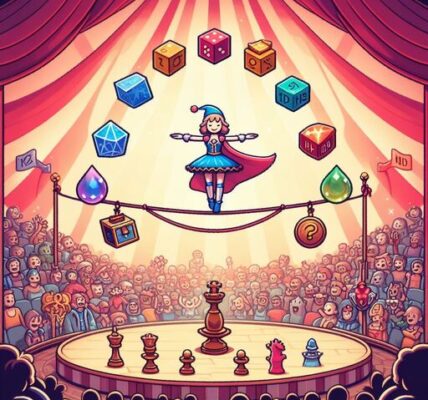Ancient Antics: Embarking on Journeys Through History in Gaming
In the interactive universe of video gaming, the genre of historical adventures offers a particularly fascinating lens through which we can view the distant past. “Ancient Antics: Embarking on Journeys Through History in Gaming” explores the intersection of ancient history and digital entertainment, focusing on how games recreate, reinterpret, and bring to life the enigmatic epochs that have shaped civilizations across the globe. From the architectural marvels of ancient Rome to the strategic complexities of the Han dynasty, these games blend educational content with engaging gameplay, offering a dynamic platform for learning and entertainment.
This series will delve deep into the realms where history meets game design, examining how developers harness technology to reconstruct ancient settings, the challenges they face in balancing historical accuracy with engaging storytelling, and the impact of these games on players’ understanding of ancient cultures. By exploring both well-known and lesser-discussed games, this series aims to provide a thorough analysis of how ancient history is presented in the gaming world, offering insights into the educational potential and entertainment value of these digital time machines.

Part 1: Building Blocks of Ancient Worlds in Games
Crafting Realistic Ancient Settings
The allure of any historical game largely hinges on its ability to convincingly recreate the period it represents. For games set in ancient times, this involves an intricate process of researching and replicating everything from architectural styles and urban layouts to clothing and everyday objects. Titles such as “Assassin’s Creed: Origins” exemplify the potential of meticulous research, featuring a rendition of Ptolemaic Egypt that was brought to life through close collaboration with historians and Egyptologists. The game not only showcases major landmarks but also immerses players in the minutiae of Egyptian life, from marketplaces bustling with traders to remote villages along the Nile.
Technology and Tools for Time Travel
The evolution of gaming technology has significantly enhanced developers’ ability to create immersive historical environments. Tools like photogrammetry capture real-world textures and details, enabling games like “Assassin’s Creed: Odyssey” to offer players a vivid journey through ancient Greece. Such technological advancements not only enhance the visual appeal of these games but also their educational value, making ancient histories accessible and engaging to a broad audience.
Part 2: Storytelling in the Sands of Time
Integrating Historical Events and Figures
Effective historical games masterfully integrate real events and figures into their narratives, giving players not just a story to play through but a history to experience. “Total War: Rome II” allows players to engage in the political, military, and social arenas of ancient Rome, involving key historical figures and battles in a gameplay that emphasizes strategy and decision-making. This integration helps contextualize ancient practices and decisions, offering insights into the complexities of historical events and their implications.
The Role of Mythology and Legend
Ancient myths and legends play a significant role in shaping the cultural narratives of societies, and many games tap into this rich vein to add depth and color to their historical settings. “Age of Mythology,” for example, combines real historical civilizations with their mythologies, allowing players to command not only armies of human soldiers but also deities and mythical creatures. This blend of history and mythology provides a more holistic view of how ancient peoples understood the world around them and how these beliefs influenced their civilizations.
Part 3: The Accuracy Debate in Ancient Gaming
Historical Authenticity vs. Creative Freedom
The debate between historical authenticity and creative freedom is central to the development of historical games. While purists might prefer strict adherence to historical facts, game developers often need to modify history for gameplay purposes. The “Sid Meier’s Civilization” series is a prime example, offering players the ability to lead a civilization from the stone age to the modern era, making decisions that can completely alter the course of history. This “what if” aspect of gaming allows for creative exploration but can also challenge players’ understanding of historical inevitability.
Educating Through Entertainment
Despite some deviations from historical accuracy, many games are committed to educating their audience about the past. They achieve this through detailed encyclopedias, interactive timelines, and in-game historical notes that provide background information on the people, places, and events encountered in-game. These features make games a powerful tool for education, capable of sparking interest in history and encouraging further exploration and learning.
Part 4: Representation and Cultural Sensitivity
Challenges in Portraying Ancient Cultures
Accurately and sensitively representing ancient cultures is one of the most significant challenges faced by game developers. This involves not only avoiding stereotypes but also responsibly handling sensitive cultural and historical issues. Games like “Assassin’s Creed: Odyssey” engage historians and cultural consultants to ensure their portrayals of ancient Greece are both respectful and accurate, helping avoid cultural misrepresentation and promoting a deeper understanding of the historical context.
The Impact on Cultural Understanding
When well-executed, games that explore ancient cultures can greatly enhance players’ understanding of and appreciation for these societies. They can demystify foreign customs and highlight the achievements and challenges of ancient peoples, promoting a sense of connectedness across time and culture. Moreover, by showcasing the interconnectedness of ancient civilizations through trade, warfare, and diplomacy, these games can foster a broader appreciation for the complexity and diversity of human history.




